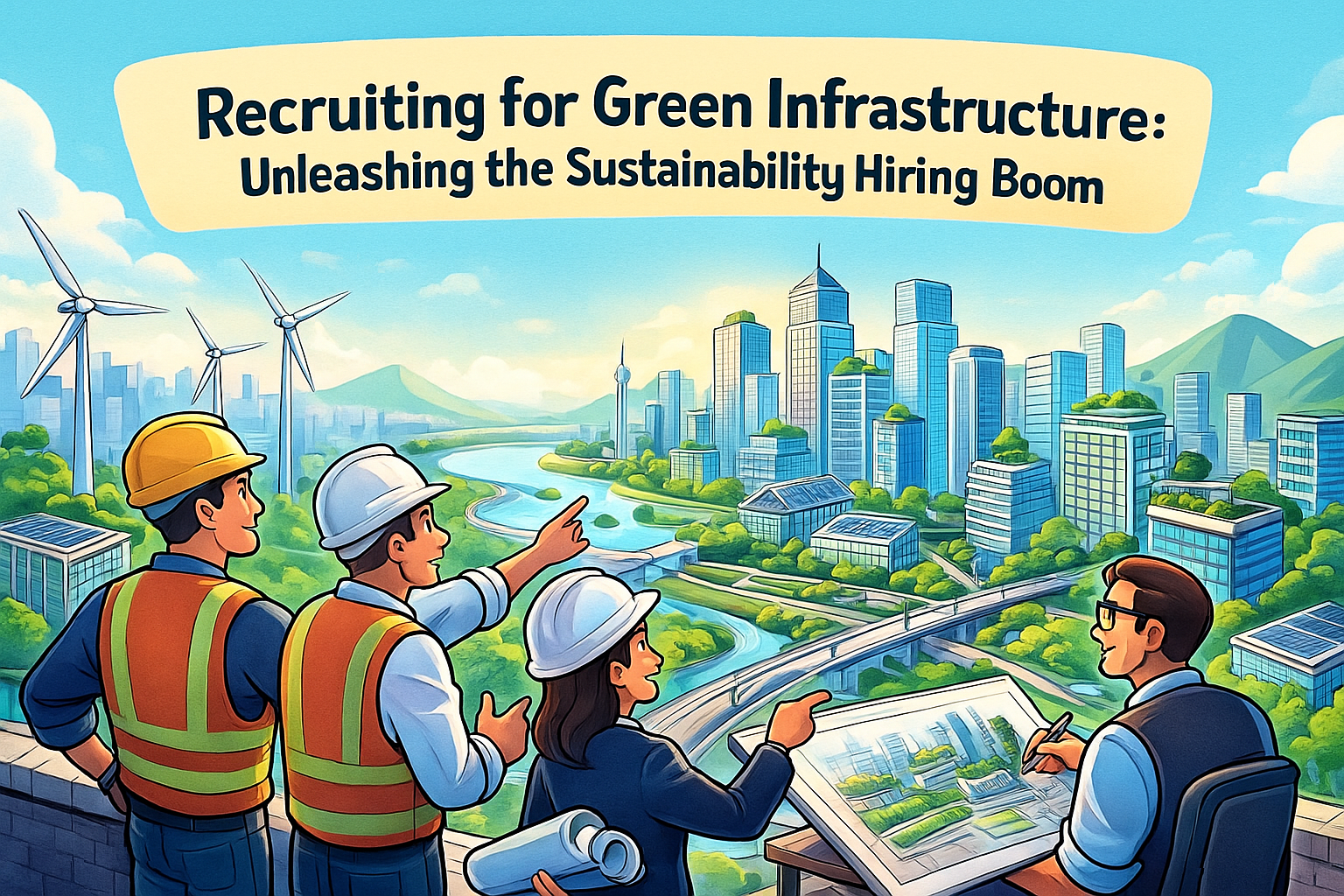Sustainability is no longer a niche priority — it’s shaping the future of infrastructure, construction, and engineering across the United States. As government agencies and private companies push to meet environmental and climate-resilience goals, they are investing heavily in large-scale green infrastructure projects such as green roofs, permeable pavements, bioswales, stormwater systems, and renewable-energy-integrated developments.
This surge is fueling a major hiring boom, creating new opportunities while also exposing talent shortages across engineering, construction, environmental science, and sustainability fields. For recruiters, the landscape is shifting quickly — and strategically navigating this new hiring frontier is essential.
What’s Driving the Green Infrastructure Hiring Boom
Massive Investment and Policy Tailwinds
Governments worldwide are pushing billions into clean energy and sustainable infrastructure. In the U.S., the Inflation Reduction Act and federal infrastructure funding have accelerated demand for environmentally focused projects. Globally, the shift toward renewable energy and nature-based solutions is fueling similar momentum.
Studies show that jobs in renewable energy alone increased by hundreds of thousands in a single year and are projected to reach tens of millions globally by 2030. Green infrastructure — a critical subset of this transition — benefits directly from these investments.
Evolving Corporate Sustainability Goals
Companies in construction, utilities, engineering, manufacturing, and technology sectors are embedding sustainability and ESG principles into their operations. This expansion requires new types of specialists, analysts, and project managers who can integrate sustainable practices into infrastructure planning, design, and execution.
Roles and Skills in Highest Demand
High-Growth Job Titles
Organizations hiring for green infrastructure projects increasingly seek:
- Green Infrastructure Specialists / Project Managers
Professionals with experience in low-impact development, nature-based solutions, and sustainable urban planning. - Sustainability Managers and Analysts
Experts in ESG reporting, carbon accounting, lifecycle analysis, and sustainability program models. - Environmental Engineers and Civil Engineers (Green-Focused)
Engineers skilled in stormwater systems, resilience planning, green roofing, and sustainable construction. - Renewable Energy Technicians and Systems Engineers
Often overlapping with infrastructure projects involving solar, wind, or distributed energy systems. - Sustainable Supply Chain or Materials Specialists
Professionals responsible for low-carbon construction materials, circular-economy models, and sustainable procurement.
Key Competencies
Beyond technical qualifications, employers are prioritizing:
- Knowledge of green infrastructure standards and nature-based designs
- Carbon lifecycle modeling and sustainability metrics
- Experience with evolving regulatory frameworks
- Cross-disciplinary collaboration (ecology, engineering, construction, community planning)
- Communication and stakeholder-engagement skills
A notable trend is the shift toward skills-based hiring, with employers valuing competency and experience over formal degree requirements in many cases.
The Green Infrastructure Talent Gap
Even with rising demand, the available workforce is not keeping pace. Many organizations—both public and private—report shortages of qualified workers across engineering, construction, and sustainability-focused roles.
Key contributors to the gap include:
- Rapidly expanding project pipelines
- Limited specialized training programs
- Underdeveloped cross-disciplinary career paths
- Increasing competition for top talent
- Higher salary expectations in sustainability-targeted roles
As a result, companies must rethink recruitment, development, and retention strategies to remain competitive.
Best Practices for Recruiting Green Infrastructure Talent
1. Expand and Diversify Your Recruiting Pipeline
Look beyond traditional degree programs. Professionals from environmental science, geology, ecology, urban planning, or landscape architecture often have transferable skills that align with green infrastructure needs.
Leaning into skill-based job descriptions helps draw talent that may otherwise be overlooked.
2. Strengthen Employer Branding Around Sustainability
Today’s workforce values purpose-driven work. Highlighting an organization’s environmental commitments, sustainability goals, and green project portfolio can significantly attract mission-aligned candidates.
3. Prioritize Internal Upskilling
Because the talent pool is limited, many companies are training their existing engineers, project managers, and construction professionals through sustainability certifications, partnerships with universities, and green-skills development programs.
4. Build Interdisciplinary Teams
Green infrastructure sits at the crossroads of engineering, environmental science, and community development. Strong teams bring together varied backgrounds — and recruiters should hire with this collaborative approach in mind.
5. Retain Talent Through Purpose, Growth, and Culture
Green infrastructure professionals often value:
- Mission-oriented work
- Opportunities to innovate
- Clear career paths
- Ongoing learning and certification support
Retention strategies must match these motivations to maintain a competitive edge.
Conclusion
The green infrastructure hiring boom is reshaping the workforce needs of engineering, construction, utilities, and environmental sectors. As investment accelerates and sustainability goals tighten, organizations that cultivate strong talent pipelines, expand their hiring criteria, and invest in training will be best positioned to succeed.
Key Takeaways:
- Green infrastructure is driving one of the fastest-growing hiring sectors in the U.S.
- Employers face a major skills shortage and rising competition for qualified candidates.
- Skills-based hiring, upskilling, and strong employer branding are crucial for securing top talent.
- Sustainability expertise is becoming a core requirement across the infrastructure lifecycle.
FAQ
Q: Do I need a specific sustainability degree to work in green infrastructure?
Not necessarily. Many employers now prioritize practical skills and applied experience, and they often welcome candidates from engineering, construction, landscape architecture, or environmental science backgrounds.
Q: What regions are seeing the most growth?
In the United States, major funding programs are driving nationwide growth, with strong demand in urban centers, coastal regions, and areas implementing climate-resilience initiatives.
Q: Are salaries higher in green infrastructure jobs?
Generally, yes. Many sustainability-aligned roles carry notable salary premiums due to talent scarcity and specialized skill requirements.
Sources
- World Economic Forum – Renewable energy growth and green jobs
- U.S. Environmental Protection Agency – Jobs in green infrastructure
- Jobspikr – Sustainability and green jobs trends
- Construction Placements – Green Infrastructure Specialist role
- Sustainability Magazine – Growth in sustainability and ESG careers
- The Interview Guys – The green skills revolution
- arXiv – Research on green-skills labor markets
- OneStopESG – The green job boom and worker shortages

